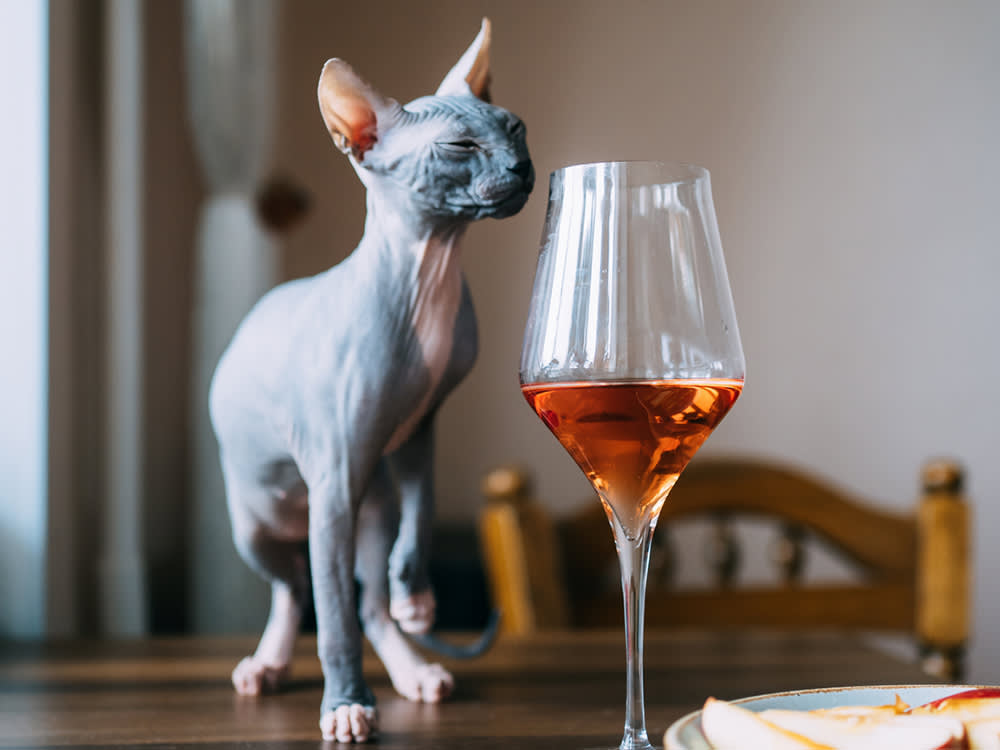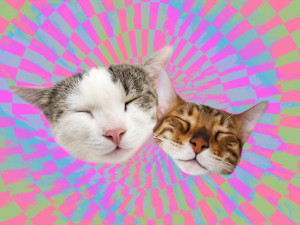How is Cat Wine Still a Thing?
It’s five o’clock somewhere, but read this before you share a glass with your pet.

Share Article
If ever there was a meme that spoke directly to my soul — and there are a great many contenders on the internet — it’s a drawing of a man sitting on a sofa with a bunch of cats. They each have a glass of wine. The caption reads, “Where do you see yourself in 10 years?” Hashtag goals, indeed.
My cat and I share a bond so close it seems almost impossible that we could get any closer. But then I wonder what it would be like to communicate with her in the same language, to discuss the perils of climate change or the newest villain on The Bachelor over a jammy red. We might actually connect even better than we already do. The need, if you can call it that, is there.
Lo and behold, it turns out that cat wine, an incredibly niche product that seems to have been introduced to the pet marketplace sometime in the 2010s, exists to fill that void. Dogs have their own canine wine (as well as beer and pupaccinos — the list goes on), so it seems only fair for cats to get in on the human-esque food and beverage action.
Cat wine, as you might expect, is not alcoholic or fermented or made from grapes, but is in fact just catnip water dyed with beetroot to resemble white and red wines. Packaged in little nip-size bottles, cat wine is fairly affordable with a price range of $5 to $20, looks adorable on the shelf, and succeeds in its intention to appeal to the human consumer. It’s meant to relax cats who are fans of catnip’s mellowing, euphoric effects.

The question is, does it function as you might want it to, as an actual beverage for a cat? I tested Apollo Peakopens in new tab’s products out on two real cats (not paid actors), including mine (KB) and another guy (DM) who comes around regularly to get fed and hang out. KB hates water of any kind — doesn’t even want to look at it. DM is the thirstiest cat I’ve ever met. You put a bowl of water in front of him and you can count on him to drink. On the catnip front, KB is indifferent to the stuff. DM goes nuts for it.
I offered KB samples of both the red (Pinot Meow) and white (Moscato) cat wines, and she rejected both after giving them each a cursory sniff. It didn’t matter the vessel — I tried cups and cat dishes. To my surprise, DM was equally disinterested in the catnip wine. My tests suggested (to me, anyway) that cat wine is not meant for cats, but only for human amusement. Perhaps they could make a cute white elephant gift at your next holiday party, or a gag gift for a cat lover’s birthday.
“Personally, I’m not sure it’s worth spending the money on products like these,” says Dr. Sarah Dougherty, veterinarian and medical director at Cornell Center Animal Hospital. “Professionally, I’m sure it’s fine.” Dr. Dougherty’s primary concern, if a cat should take to cat wine, is that it’s unclear how the catnip is sourced and what the dosage of catnip is in each serving. Taken often, she warns, the cat wine could potentially lead to a nutritional imbalance in your cat.
If you are interested in treating your cat to some cat wine, Dr. Doughtery’s recommendation is to start very slowly, with a much smaller amount than the recommended serving. “But,” she says, “to be quite honest, I would never give this to my cat.”

Helin Jung
Helin Jung is a writer in Los Angeles.

